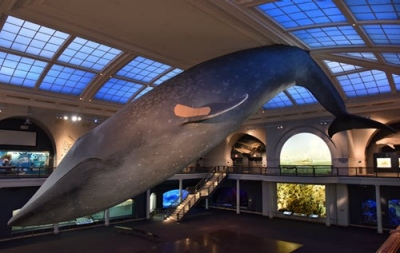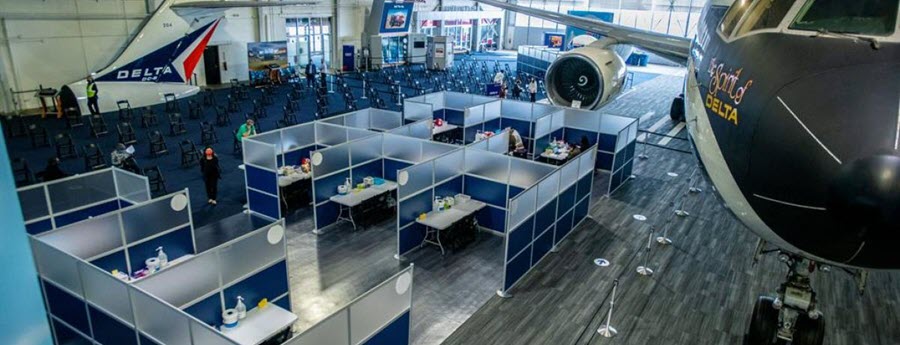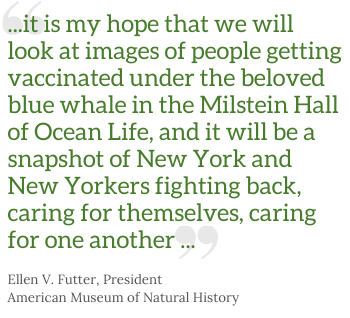Libraries and Museums as Vaccination Sites
"Welcome. Would you like a vaccine with your dose of culture today?"

offered beneath the whale.
Libraries and museums are innovative community centers, and throughout the COVID-19 pandemic, they have been essential to the community and national response. In addition to continuing to provide for their communities with curbside services and virtual programs, many locations are serving as testing sites, providing families with free food, sharing their collections with socially isolated community members, and using 3D to make PPE.
The next big venture in pandemic response? Stepping in to assist with the US government administration’s goal of providing a vaccination site within five miles of the homes of 90% of the US population. The engagement of museums and libraries in these efforts also isn’t unique to US institutions, as the global community pursues broad vaccination efforts.
The power of place and space
Several factors make libraries and museums primed for this new role: multiple and accessible locations, facilities that are ADA-compliant, safety features such as security cameras, and long-standing commitments to addressing community challenges––particularly with underserved populations––such as inclusion, equity, and access to accurate information.
Library and museum vaccination sites range from large-scale, extended efforts to one-time pop-ups. The Richard Nixon Presidential Library and Museum hosted a single-day vaccination event in April, with more events expected to occur in the future. Multiple branches of the Hartford Public Library have been hosting both pop-up and sustained vaccination clinics in partnership with state and local health authorities while also helping making appointments for folks with limited technology access. “This was an opportunity for the library to assure people that vaccines are safe, that they improve peoples’ lives and that they help halt the spread of this disease,” said Steven Scarpa, Manager of Communications and Public Relations at Hartford Public Library. As of mid-May, more than 550 people from some of the most vulnerable parts of the city have accessed free vaccinations.

By contrast, the vaccine effort at the Delta Flight Museum (image above) has gone through many iterations, first taking advantage of the museum’s ample parking with a drive-through vaccine clinic before moving operations inside the museum’s spacious galleries. “Since [closing to visitors in March 2020], we have been repurposed as a socially distanced Delta Air Lines reservations call center, a Delta employee COVID-19 testing facility, and now the site of not one, but two COVID-19 vaccination centers for both Delta and the general public,” said Tiffany M. Meng, Director of Operations for the Delta Flight Museum. “We’ve been honored to help our community through this challenging time by using our space and staff in these unique ways, and we look forward to welcoming visitors again later this summer once the vaccination sites wrap up.”
Aligning with the mission
 Sometimes the vaccination effort connects not just with an institution’s community, but with its mission. After a year of closure, the Science Museum in London reopened in March as host to a National Health Service vaccination clinic in one of its empty galleries, acting as the first national museum in the United Kingdom to open as a vaccination site. “Uniquely, our museum can both tell the story of how vaccination has saved millions of lives, and also play a part in ensuring vaccines protect the nation from COVID-19,” said Sir Ian Blatchford, Director and Chief Executive of the Science Museum. “It is an extraordinary sensation to be collecting and living history all at once.” In the halls of another renowned science institution, New Yorkers can get inoculated under the iconic blue whale at the American Museum of Natural History, receiving museum vouchers along with their shots. “In years to come, it is my hope that we will look at images of people getting vaccinated under the beloved blue whale in the Milstein Hall of Ocean Life, and it will be a snapshot of New York and New Yorkers fighting back, caring for themselves, caring for one another, and of the time when things started to turn for the better,” said Ellen V. Futter, President of the American Museum of Natural History.
Sometimes the vaccination effort connects not just with an institution’s community, but with its mission. After a year of closure, the Science Museum in London reopened in March as host to a National Health Service vaccination clinic in one of its empty galleries, acting as the first national museum in the United Kingdom to open as a vaccination site. “Uniquely, our museum can both tell the story of how vaccination has saved millions of lives, and also play a part in ensuring vaccines protect the nation from COVID-19,” said Sir Ian Blatchford, Director and Chief Executive of the Science Museum. “It is an extraordinary sensation to be collecting and living history all at once.” In the halls of another renowned science institution, New Yorkers can get inoculated under the iconic blue whale at the American Museum of Natural History, receiving museum vouchers along with their shots. “In years to come, it is my hope that we will look at images of people getting vaccinated under the beloved blue whale in the Milstein Hall of Ocean Life, and it will be a snapshot of New York and New Yorkers fighting back, caring for themselves, caring for one another, and of the time when things started to turn for the better,” said Ellen V. Futter, President of the American Museum of Natural History.
As beloved public institutions and with staff who are seen as trusted sources of information, libraries and museums are poised to make a difference in the vaccine effort. Hosting a vaccination site sends a strong, visible message about COVID-19 vaccines and the science behind them. LAMs can also help address vaccine hesitancy through connecting visitors and patrons with content experts who can answer their specific questions, and through programming that aims to increase science literacy generally. This is a natural extension of the work that LAMs have always done, and will always do, to nurture the communities they serve.
Additional examples of museums and libraries supporting vaccination efforts
Naval Air Station Wildwood Aviation Museum
Children’s Museum of Skagit County
American Museum of Natural History
More resources are available through the REALM project website.
This project was made possible in part by the Institute of Museum and Library Services, project number: ODIS-246644-ODIS-20.
